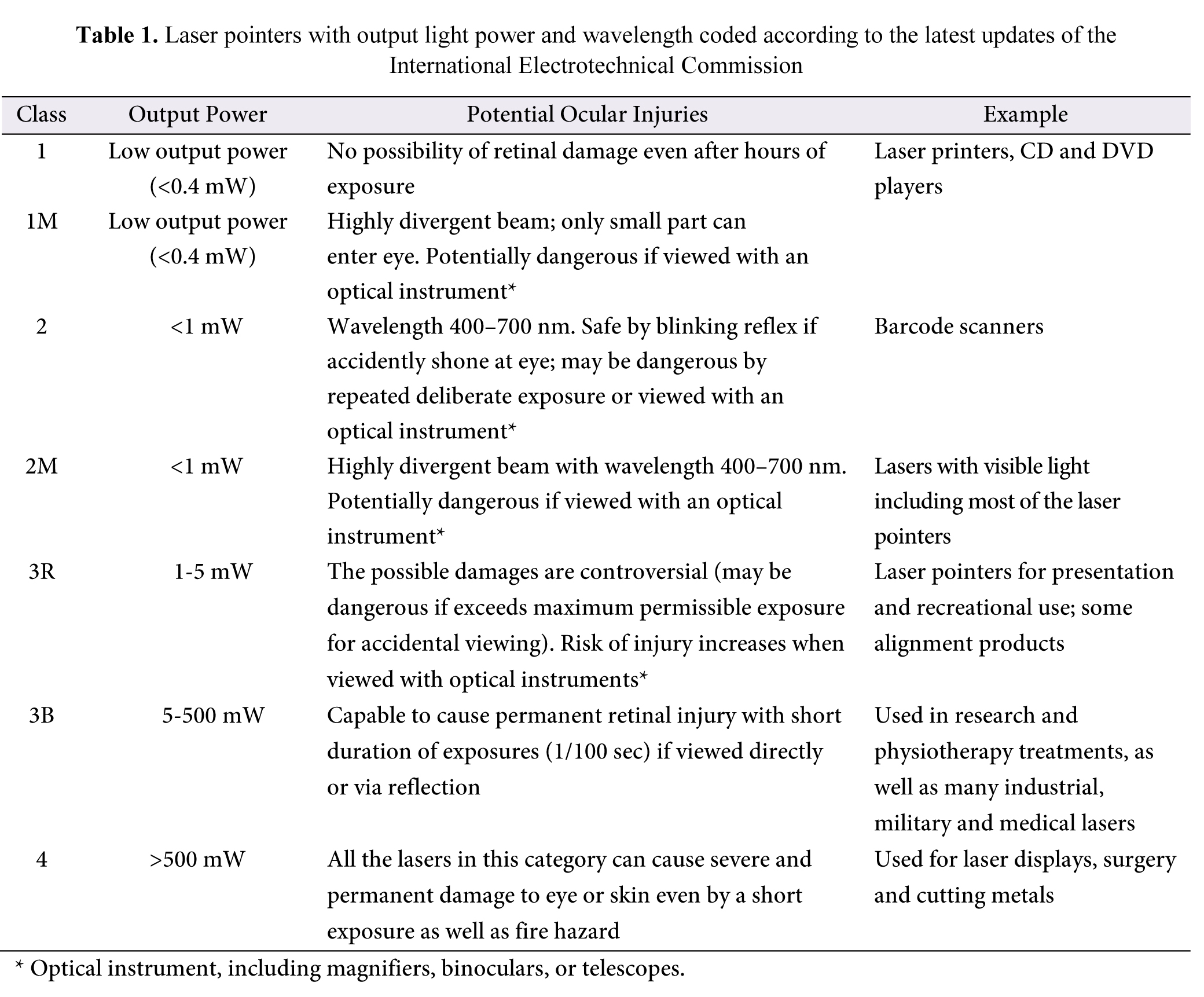Abstract
While light is a visible and narrow range of the electromagnetic spectrum that is responsible for vision, Light Amplification by Stimulated Emission of Radiation (laser) is a monochromatic and polarized beam with a specific frequency and minimum divergence from this spectrum (1). Since the invention of the laser in 1960, its use has become widespread in everyday life. Moreover, during the notable advances in technology in the past decades, laser devices have been used in a wide variety of applications, from educational fields to medical, military, and cosmetic purposes, and sometimes even mistakenly used by children as toys (2).
Laser pointers are known as low-energy devices that emit focal non-ionizing beams that are widely used in lecture halls for educational-commercial presentations and even sometimes in passages and ceremonies for advertising and elegance purposes (1). These markers exist in different types based on the wavelength of the light beam, and consequently the color of the emitted light, which is usually red (650-670 nm) or green (532 nm) (2).Laser pointers are coded by output light power and wavelength. In the latest updates, the International Electrotechnical Commission has classified laser devices into four categories based on maximum output power, where handheld laser pointers are usually classified as 2M or sometimes 3R (Table 1) (3). According to this classification, 2M types are considered safe due to their low output power and highly divergent light beam, along with the protective effect of the blink reflex, which reduces the exposure time of the laser light with the internal structures of the eye. However, possible eye damage in class 3R is controversial, especially during accidental exposure or accompanied with the use of optical tools such as magnifying glasses, binoculars or telescopes (4), and long-term viewing and deliberate direct observation (5). So, there is the possibility of severe eye damage in both classes, which has been reported in previous studies (2, 6).
The most common ocular structure involved in laser injuries is retina due to the following two reasons: 1) it is optically transparent and 2) the refractive power of the eye focuses the radiation on the retina. It should be noted that the energy of radiation rays on the retina is more than 105 times in the cornea (7), which can reach a million times in the presence of the previously mentioned optical tools (8). Eye damage by laser devices depends on the wavelength, exposure time, characteristic of eye refraction, and laser-ocular tissue interaction. In general, laser-ocular tissue interaction has three mechanisms as follows (7):
1) Thermal (photothermal): the laser energy absorbed by the pigments causes an increase in the local temperature and coagulation of tissue proteins, and finally cell death and scar formation;
2) Mechanical: laser energy is quickly absorbed in a very short period, and this sudden increase in temperature causes the liquid to evaporate, followed by the creation of a mechanical wave; and
3) chemical (photochemical): tissue chemical reactions caused by laser energy without a substantial increase in temperature. In this context, thermal damage is considered the most important mechanism in laser damage, which mainly occurs in short-wavelength lasers (i.e., green laser). In these injuries, retinal pigments act as mediators in the laser phototoxicity (4).
So far, many reports have mentioned a wide range of damaging effects of lasers on the retina, including retinal holes (9), retinal hemorrhage (2), choroidal neovascularization (CNV) (10,11), photoreceptors damage (6), etc. Nowadays, retinal damage caused by laser pointers is a matter of concern due to such factors as easy availability, cheap price, and widespread use (recreational and advertising use), as well as the lifelong visual disability that often affects children and young people, as active people in the community. In general, although there is no consensus regarding the effects of laser pointers, especially in class 2M, many countries have strict rules regarding public use, even as toys and advertising equipment. To our knowledge, no legal restrictions have been issued for the use of handheld laser devices and all advertising types in Iran. During the six years of my professional activity as an ophthalmologist (from 2014 to 2020), I encountered only two cases of eye damage following laser exposure, both of which were published as case reports (2,6). However, many cases of ocular injuries (at least one case per week) were referred to the ophthalmic center of Kermanshah, Iran between 2021 and 2023, which were usually due to the use of handheld lasers as toys and sometimes contact with colored laser beams in the public places. Previous studies warned about the eye damage caused by these pointers (5,12,13). Nonetheless, there is not enough evidence-based information on this issue in Iran. Previously, the author of this article published two case reports in international journals; one patient suffered retinal hemorrhage following contact with a green laser pointer, and the other patient suffered a macular hole following contact with advertising laser beams on the street (2,6). In conclusion, I recommend increasing public awareness about the harmful effects of using laser pointers in different ways, including the use of social media. Also, some policies should be designed to ban the use of these tools at the community level, especially in toy stores.
